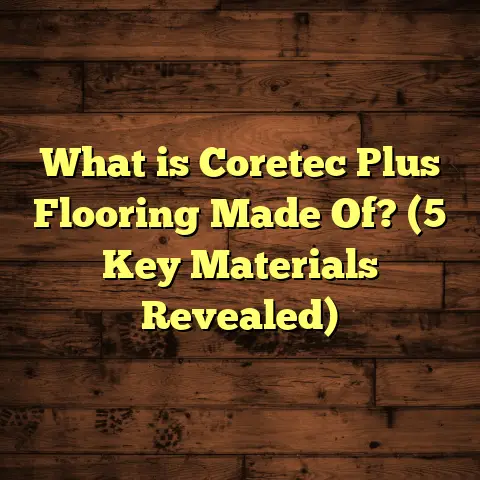What is Polyurea Flooring? (5 Benefits for Durable Spaces)
I remember the first time I heard about polyurea flooring. A client called me out of the blue, frustrated with the constant wear and tear on their garage floor. They needed something tough, quick to install, and long-lasting. After installing polyurea for them, the results blew me away. Not only did it hold up incredibly well, but it also looked great and required minimal maintenance. That’s when I realized polyurea flooring isn’t just good—it’s a must-have for anyone wanting durable spaces.
What is Polyurea Flooring?
So, what exactly is polyurea flooring? Simply put, polyurea is a type of coating made from a reaction between an isocyanate and a synthetic resin blend. This chemical reaction creates a super strong, flexible, and fast-curing material that’s applied as a coating over floors. It’s often used in industrial settings but has lately become popular for residential and commercial floors too.
Unlike traditional epoxy or polyurethane coatings, polyurea cures much faster—sometimes within minutes—and offers superior resistance to chemicals, abrasion, and UV exposure. It forms a seamless surface that protects the underlying concrete or substrate from damage, moisture, and staining.
How Does Polyurea Work?
Here’s a bit of the science behind it: when the two components mix, they undergo a chain reaction forming long molecular chains that give polyurea its elasticity and toughness. This is why it can handle heavy traffic and impacts without cracking or peeling.
I’ve used polyurea in spaces ranging from warehouses to home gyms, and each time I’m impressed by how quickly the floor is ready for use after installation.
5 Benefits of Polyurea Flooring for Durable Spaces
Let me break down the top benefits I’ve seen firsthand when using polyurea flooring.
1. Incredible Durability and Impact Resistance
If you want flooring that lasts, polyurea is your answer. It’s highly resistant to abrasion and impact. For example, in one of my projects—a commercial automotive workshop—the floor was subjected to constant heavy machinery and dropped tools. After two years, the floor showed almost no signs of wear.
Polyurea’s molecular structure allows it to absorb shocks without cracking like regular epoxy might. According to industry data, polyurea coatings have a tensile strength of up to 3,500 psi, compared to around 2,500 psi for epoxy.
To give you an idea of what this means in practical terms: imagine forklifts running constantly across your warehouse floor. Epoxy might chip or crack under such pressure within months. Polyurea holds up like a champ. This durability reduces repair costs and downtime during your business operations.
2. Lightning-Fast Cure Time
One thing that always impresses my clients is how quickly polyurea floors cure. Unlike epoxy or polyurethane floors that can take days to fully harden, polyurea can cure in as little as 1-2 hours under ideal conditions.
In practical terms, this means less downtime for businesses or homeowners who need their space back fast. I had a retail client who needed new flooring but couldn’t close shop for more than a day. Polyurea allowed us to finish the job overnight with zero disruption.
The speed also minimizes dust and dirt contamination during installation since the window for exposure is so short. From my experience, that’s a huge plus in busy environments where cleanliness is critical.
3. Superior Chemical and UV Resistance
Spills happen—whether it’s oil in your garage or cleaning chemicals in a commercial kitchen. Polyurea’s chemical resistance protects floors from stains and degradation.
Plus, unlike epoxy which tends to yellow or chalk under UV exposure, polyurea maintains its color and finish even in outdoor settings. For example, I installed polyurea coatings on an outdoor patio area exposed to full sun for over three years—and the color stayed vibrant with no peeling or fading.
This UV stability makes polyurea perfect not just indoors but also for exterior applications like parking garages or walkways.
4. Flexibility and Crack Bridging
Concrete can crack over time due to settling or temperature changes. Polyurea’s flexibility allows it to bridge small cracks without breaking apart. I once worked on a warehouse floor with visible hairline cracks; after applying polyurea, those cracks remained sealed and hidden even after heavy forklift traffic.
This flexibility reduces maintenance costs because you’re not constantly repairing damaged coating or exposed concrete.
This property stems from polyurea’s elastomeric nature—it stretches without losing integrity. That makes it great for environments with fluctuating temperatures or slight substrate movement.
5. Low Maintenance and Easy Cleaning
Polyurea floors are incredibly easy to maintain. A simple mop or sweep is enough to keep them looking new. The seamless surface prevents dirt or bacteria buildup, making it a great choice for hygienic environments like hospitals or food processing plants.
In my experience, clients appreciate how little effort it takes to keep their polyurea floors clean compared to carpets or tiles which require more frequent deep cleaning or grout maintenance.
My Experience with Polyurea Flooring Projects
I want to share some real-world examples that highlight why I recommend polyurea so often.
Case Study: Industrial Garage Floor
A local trucking company approached me with a garage floor that was constantly cracking under heavy loads and exposure to diesel fuel. They’d tried epoxy coatings before but those peeled within months.
We installed a 1000-square-foot polyurea floor with a thickness of about 1/8 inch. The floor was ready for use within 4 hours post-application. After 18 months of daily use with heavy trucks driving in and out, the floor still looked brand new—no cracks, chips, or stains.
The client reported significant savings on repairs and downtime compared to previous coatings.
Case Study: Food Processing Plant
Food safety standards are strict in this industry. One plant I worked with wanted a floor that could handle harsh cleaning chemicals without harboring bacteria.
Polyurea was perfect because its seamless surface prevents dirt buildup and resists chemical degradation. Plus, it cured quickly which minimized production interruption during installation.
After six months of operation with daily washing cycles using strong disinfectants, the floor showed no signs of wear or discoloration.
Research Insight: Comparing Coating Lifespans
Data from the Flooring Contractors Association shows that polyurea coatings can last up to 10 years in industrial settings without major repairs, compared to 3-5 years for epoxy coatings under similar conditions.
This longevity translates into fewer replacement cycles and lower overall costs despite a higher initial price.
How Polyurea Compares to Other Flooring Options
You might be wondering how polyurea stacks up against other popular options like epoxy, polyurethane, or even polished concrete.
| Feature | Polyurea | Epoxy | Polyurethane | Polished Concrete |
|---|---|---|---|---|
| Cure Time | 1-2 hours | 24-72 hours | 12-24 hours | N/A |
| Chemical Resistance | Excellent | Good | Fair | Fair |
| UV Stability | Excellent | Poor (yellowing) | Good | Excellent |
| Flexibility | High | Low | Medium | Low |
| Durability | Very High | High | Medium | Medium |
| Maintenance | Low | Medium | Medium | Low |
From my perspective, if you need fast installation combined with durability and flexibility, polyurea is hard to beat.
Where Can You Use Polyurea Flooring?
Polyurea isn’t just for industrial spaces. Thanks to its versatility, you can use it across multiple environments:
- Garages: It handles vehicles, oil spills, and temperature changes without cracking.
- Commercial Kitchens: Resistant to harsh cleaners and easy to sanitize.
- Hospitals: Seamless surface helps maintain hygiene.
- Warehouses: Withstands heavy traffic and dropped equipment.
- Outdoor Areas: UV stable for patios or parking lots.
- Residential Spaces: Basements, gyms, laundry rooms benefit from durability and quick installation.
I’ve installed polyurea floors in many such places—and each time I get questions about whether it’s “overkill” for residential use. Honestly? For anyone valuing durability and low maintenance, it’s worth considering even at home.
Installation Process: What Happens During Polyurea Flooring Application?
Thinking about installing polyurea? Here’s what typically goes down based on my experience:
Step 1: Surface Preparation
This step is crucial. The concrete must be clean, dry, and free from contaminants like oil or grease. Usually, we use diamond grinding or shot blasting to create a rough profile that helps adhesion.
Step 2: Repair Any Damage
Cracks bigger than hairline need filling before coating goes on. Otherwise, those cracks might telegraph through the coating later.
Step 3: Mixing Components
Polyurea comes in two parts that mix just before application. The mixing must be precise—too much or too little of one part ruins the chemical reaction.
Step 4: Applying the Coating
Using specialized spray equipment, we apply polyurea evenly across the floor surface. The spray ensures seamless coverage without bubbles or pinholes.
Step 5: Curing
Polyurea cures rapidly—usually within an hour or two—depending on temperature and humidity. After curing, additional protective topcoats or decorative chips may be added if desired.
How Much Does Polyurea Flooring Cost?
Cost is often the first thing clients ask me about. Here’s what I tell them based on recent projects:
- Material Cost: Polyurea itself tends to cost between $7-$12 per square foot.
- Installation Cost: Labor adds roughly $3-$6 per square foot depending on surface prep complexity.
- Total Average: $10-$18 per square foot installed.
Compared to epoxy floors which generally run $3-$7 per square foot installed, polyurea is pricier upfront. But given its longer lifespan (often double), fewer repairs needed, and less downtime during installation—the total cost of ownership balances out favorably over time.
Common Questions Clients Ask About Polyurea Flooring
I want to answer some questions I hear all the time:
Q: Can I install polyurea over existing epoxy?
A: Usually not recommended unless the old coating is thoroughly profiled and cleaned because adhesion may be poor.
Q: How thick should polyurea coatings be?
A: Typical thickness ranges from 80 to 150 mils (about 1/16″ to 1/8″). Thicker coats offer better durability but cost more.
Q: Is polyurea slip-resistant?
A: Yes! Adding texture or aggregate chips during installation makes surfaces safe for wet areas without affecting durability.
Q: How long does installation take?
A: For most residential garages (around 500 sq ft), surface prep plus installation takes one full day including curing time.
Q: Can I DIY?
A: While DIY kits are available, professional installation ensures correct mixing ratios and application thickness which are critical for performance.
Maintenance Tips for Polyurea Floors
Keeping your polyurea floor looking fresh is simple:
- Sweep regularly to remove grit that can scratch.
- Mop with mild detergent; avoid harsh chemicals.
- Address spills promptly especially if they involve oils or acids.
- Avoid dragging heavy sharp objects across the surface.
- Annual inspection helps spot any damage early before it worsens.
Environmental Impact of Polyurea Flooring
If sustainability matters to you like it does to me, here’s what you should know:
Polyurea coatings contain low levels of volatile organic compounds (VOCs) compared to many other coatings—meaning fewer harmful fumes during application. The fast cure time reduces energy consumption as well since no prolonged drying rooms are necessary.
Some manufacturers now produce bio-based polyureas made partially from renewable sources—an encouraging trend toward greener flooring solutions.
Trends Driving Polyurea Popularity
Why has polyurea grown so much in popularity recently? Here are some reasons:
- Faster project turnaround times demand quick-curing materials.
- Increased focus on durability reduces maintenance budgets.
- More awareness of chemical resistance needed in specialized industries.
- Advances in spray technology make application more efficient.
- Desire for seamless hygienic floors in healthcare/food sectors.
- Expansion into residential markets for long-lasting garage/residential floors.
What Are the Limitations of Polyurea Flooring?
No flooring solution is perfect—polyurea included:
- Higher Initial Cost: Not ideal if budget is tight and short-term costs matter most.
- Surface Prep Demands: Requires thorough prep; cutting corners leads to failures.
- Application Skill Required: Mistakes during mixing/application ruin performance.
- Temperature Sensitivity: Too cold or hot environments complicate installation.
- Not DIY-Friendly: Best left to pros for guaranteed results.
Knowing these limitations upfront helps set realistic expectations so you get great results without surprises.
Exploring Decorative Options With Polyurea
If you think polyurea floors are just plain industrial gray—think again! Polyurea offers many decorative possibilities:
- Color Customization: Choose solid colors or custom blends.
- Metallic Finishes: Unique shimmering effects achieved by special pigments.
- Flake Systems: Broadcast colored chips into wet coating for textured looks.
- Quartz Aggregates: Add sparkle plus slip resistance.
- Matte or Glossy Topcoats: Adjust sheen level based on preference.
I love helping clients create spaces that look amazing while still being tough enough for daily use. One client turned their garage into a man cave with metallic blue polyurea—it became the envy of their neighborhood!
How Polyurea Enhances Safety
Safety is always on my mind when installing floors:
- The seamless surface reduces tripping hazards.
- Slip-resistance options protect against falls in wet areas.
- Chemical resistance means fewer harmful spills seeping into cracks.
- Fast curing means less time exposed to wet hazardous floors during installation.
These factors make polyurea a smart choice not only for durability but also for creating safer environments at work or at home.
Polyurea Flooring vs Traditional Concrete Sealers
You might wonder why not just seal concrete instead of applying polyurea?
Concrete sealers penetrate or coat concrete but lack the physical toughness of polyurea films. Sealers wear away quickly under heavy traffic and don’t repair cracks or protect against chemical spills effectively.
Polyurea creates a thick protective layer that actually strengthens your floor rather than just protecting it temporarily like sealers do.
How Climate Affects Polyurea Performance
I always ask clients about local climate before recommending flooring options:
Polyurea performs well across many climates due to its flexibility:
- In cold climates: it resists freeze-thaw cracking better than rigid coatings.
- In hot climates: UV resistance prevents yellowing/fading common with epoxies.
- Humid environments: excellent moisture barrier properties prevent mold/mildew underfloor issues.
Still, installers must adjust application techniques depending on temperature/humidity levels during installation for best results.
DIY vs Professional Installation: What You Should Know
I often get asked if homeowners can install polyurea themselves:
While DIY kits exist promising easy application, professional installation offers many advantages:
- Proper surface prep tools like diamond grinders aren’t usually available at home.
- Spray equipment ensures even coverage impossible by brush/roller methods.
- Correct mixing ratios critical for curing success require professional equipment.
- Experienced installers can handle tricky situations like uneven slabs or cracks better.
From personal experience installing dozens of polyurea floors every year—I strongly recommend going pro unless you’re extremely confident in your skills and equipment.
Polyurea Flooring Maintenance Case Study
I worked with a client who installed polyurea flooring in their food processing warehouse two years ago. They called me recently asking how best to maintain it during heavy cleaning cycles involving steam mops and strong detergents.
After inspecting the site I advised:
- Use pH-neutral cleaners instead of harsh acids/alkalis to prolong coating life.
- Implement routine inspections especially near loading docks where impacts are common.
- Schedule annual professional deep cleaning using soft scrubbers instead of abrasive tools.
- Address any minor scratches immediately with touch-up kits available from manufacturers.
Following these recommendations has kept their floor looking pristine with no downtime needed so far—saving them thousands annually compared to epoxy-coated competitors who faced re-coating every few years due to damage from chemicals and cleaning processes.
Final Thoughts on Polyurea Flooring
If you’re looking for a flooring solution that combines strength, speed of installation, low maintenance with aesthetic appeal—polyurea flooring checks all those boxes.
From my hands-on experience installing hundreds of these floors across diverse industries combined with solid industry data—polyurea stands out as one of the toughest and most versatile options available today.
Have you ever dealt with frustrating floor damage? Or been stuck waiting days for your floor to dry? I’d say give polyurea a shot—it might just change your perspective on what durable flooring can be.
If you want tips on installation or choosing the right finish for your project—just ask! I’m here to help you get that perfect floor that lasts for years without hassle.





